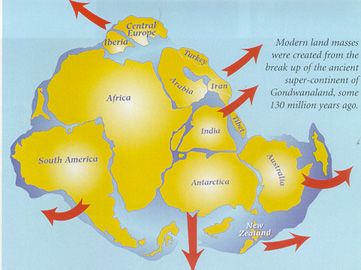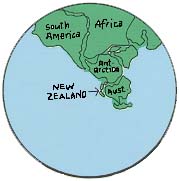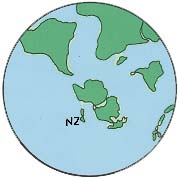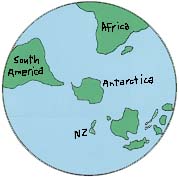 |
|
---> HOME |
 |
|
---> HOME |
Gondwana was a part of Pangea that
drifted away, and then kept breaking up further. If you look at the diagram on the
right, you can see how New Zealand used to be joined to
other countries, and how it has moved away.

 |
Around 140 million years ago, Gondwana slowly began to split apart. |
 |
80 million years ago, the piece of Gondwana that is now New Zealand drifted away from the other countries. |
 |
60 million years ago, here it was. It did not drift near any other countries or join up with any other lands. |
 |
And there it was, all alone in the ocean, like a raft with a special crew of plants and animals. |
Primitive animals lived in Gondwana. They became marooned on the islands of New Zealand, isolated from other lands. They were the ancestors of moa, kiwi, tuatara and giant snails, earthworms and weta.
In other lands different animals
began to evolve. Animals appeared which had live babies and
suckled them on milk. They are called mammals. You are a
mammal. Mammals spread over the other lands but the sea was
like a moat around New Zealand. Mammals which couldn't fly,
couldn't get to New Zealand. So the animals from old Gondwana went
on living in New Zealand in a land with no mammals to eat
them, or take their food. Only flying animals could get to
New Zealand, and bats are the only mammals that can fly. So
bats came to New Zealand, along with flying insects and some
birds. The plants of Gondwana were
primitive. There were many ferns and cone-bearing species
(some of which have become extinct), and the earliest
flowering plants. These plants were also marooned on the
islands of New Zealand. The seeds of some new plants managed
to reach New Zealand by floating across the seas, being
blown by the wind or carried in the bellies of birds - these
plants became natives too. Most countries share their native
plants with other countries, but not New Zealand. Many of
our native plants are endemic, meaning they are only found
in New Zealand. Today, most ancient plant and animal
species have disappeared from other lands, but many still
survive in New Zealand.
Because of its isolation and lack of land mammals, New Zealand became
a land filled with unique animals, ancient frogs with no tadpoles,
insects as big as mice and birds that did not fly.
